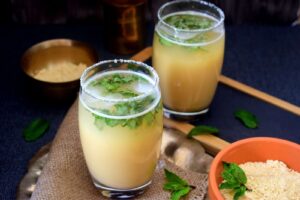Mukta Munshi
As we observe the Poshan Maah, we bring you five Ayurvedic classical recipes from different different states that are rich in nutrition and can be consumed by people of all ages. What’s more: The ingredients are locally grown and hence easily available.
Sattu ka sharbet
Popular in states like Bihar, Jharkhand, West Bengal and Uttar Pradesh, Sattu is rich in nutrients and can either be had as a sweet drink or salty. For making a salty drink, add two teaspoons of Sattu powder in a glass of water water and mix with some chopped onion, lemon juice and cumin powder with salt to taste. The sweet drink can be made by mixing it with a glass of milk with sugar/jiggery powder. Either ways it is a complete breakfast drink, especially beneficial in summers as it protects against heatstroke.
Sattu is also used in making ‘litti’, parathas, upma, or even porridge.

Sesame laddoos
Grown in West Bengal, Madhya Pradesh, Rajasthan, Uttar Pradesh, Gujarat, Andhra Pradesh and Telangana, Sesame seeds are a good source of energy due to their high fat content. They contain healthy fats like polyunsaturated fatty acids and Omega-6 besides fiber, iron, calcium, magnesium and phosphorus all of which helps boost energy levels, promote hair growth, bone health, boosts digestion, and also help fight stress and depression. These can be used as laddoos after blending with warm jiggery or can be had as Til Pitha, Til Gajak, commonly during winters. One can also consume by sprinkling sesame seeds over cereals, noodles or rice.
Jhangore Ki Kheer
Called Barnyard Millet, Jhangora is grown in Uttarakhand. Being gluten-free it is easy to digest. It is highly nutritious, least allergenic and being non-acidic very easy to digest. The kheer can be prepared with milk but you must soak Jhangora in water for some time before mixing with milk so that it becomes soft.
Niger seeds Laddoo
Niger is grown in a number of states like Odisha, Andha Pradesh, Assam, Chattisgarh, Gujarat, Jharkhand, Karnataka, Madhya Pradesh, Maharashtra, and West Bengal. The seeds can be used as a condiment and also cold pressed for obtaining edible oil. These seeds are rich in micro and macro nutritients and help fight malnutrition. And being rich in iron, these fight against anemia in adolescent girls and athletes.
Amalaki Panaka
Amla is grown in Uttar Pradesh, Gujarat, Maharashtra, Madhya Pradesh, Rajasthan, and Tamil Nadu. The traditional juice of amla is called Amla panaka. It is rich in calcium, potassium, vitamin C, B complex and antioxidants, and protects against osteoarthritis, atherosclerosis, anemia, peptic ulcer, urinary tract infection, dysentery, and high blood pressure. Panaka is prepared with boiled and cooled water, sugar/jiggery/honey and salt as required. Put in a pinch of powdered ginger and cardamom to enhance taste.